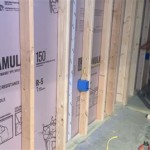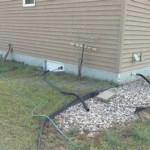How Does A Basement Perimeter Drain Work?
A basement perimeter drain, also often referred to as a French drain system, is a crucial element in managing groundwater and preventing water intrusion into basements. The system operates on the principles of gravity and hydraulic pressure to redirect water away from the foundation, thus safeguarding the structural integrity of the building and preventing moisture-related problems within the living space. Understanding the mechanics of a basement perimeter drain involves examining its components, functionality, and the hydrogeological context in which it operates.
The fundamental purpose of a perimeter drain is to intercept groundwater before it can exert hydrostatic pressure against the basement walls and floor. Hydrostatic pressure arises from the weight of water pressing against subterranean surfaces. If this pressure is not relieved, water can seep through cracks, joints, and porous materials, leading to dampness, mold growth, and structural damage. A properly installed perimeter drain system provides an alternative pathway for water, directing it away from the basement and towards a designated discharge point.
Components of a Basement Perimeter Drain System
A typical basement perimeter drain system comprises several key components working in concert to achieve effective groundwater management. These components include the drainpipe itself, a filter medium, and a sump pit with a pump. The precise configuration and materials used may vary depending on the specific site conditions and the design of the system.
The drainpipe is generally a perforated or slotted pipe, typically made of PVC or corrugated plastic. The perforations allow water to enter the pipe from the surrounding soil. The size and spacing of the perforations are designed to facilitate water entry while preventing the ingress of soil particles that could clog the system. The drainpipe is laid around the perimeter of the basement, either on the interior or exterior of the foundation wall.
The filter medium, often gravel or crushed stone, surrounds the drainpipe. This layer serves multiple purposes. It acts as a filter, preventing fine soil particles from entering the pipe and causing blockages. It also provides a high-permeability zone around the pipe, allowing water to flow freely towards the drain. The filter medium should be carefully selected based on the soil type and drainage characteristics of the site. A geotextile fabric is frequently used to wrap the gravel, further enhancing its filtering capabilities and preventing soil migration.
The sump pit is a basin installed at the lowest point of the perimeter drain system. It is designed to collect the water that flows through the drainpipe. A sump pump, located within the pit, automatically activates when the water level reaches a predetermined threshold. The pump then discharges the water away from the foundation, typically into a storm sewer, a dry well, or a designated drainage area. The sump pump is a critical component, as it ensures that the water collected by the drain system is effectively removed from the site.
Operational Principles of a Perimeter Drain
The operation of a basement perimeter drain system is governed by fundamental principles of hydrology and soil mechanics. The system exploits the tendency of water to flow along the path of least resistance and utilizes gravity to direct water towards the designated discharge point.
Groundwater naturally flows through the soil, seeking areas of lower hydraulic pressure. The perimeter drain system creates a zone of lower pressure around the foundation. The highly permeable filter medium facilitates water flow towards the drainpipe. Water enters the pipe through the perforations and flows along the pipe towards the sump pit, driven by gravity. The slope of the drainpipe towards the sump pit is crucial for ensuring efficient drainage.
The sump pump plays a vital role in overcoming elevation differences and discharging the collected water uphill or to a remote location. The pump is typically equipped with a float switch that automatically turns the pump on when the water level in the sump pit rises sufficiently. The pump capacity must be appropriately sized to handle the anticipated volume of water, taking into account factors such as rainfall intensity, soil permeability, and the extent of the drainage area.
The effectiveness of a perimeter drain system is dependent on its proper installation and maintenance. The drainpipe must be laid at the correct depth and slope, and the filter medium must be adequately sized and properly installed. Regular inspection and maintenance of the sump pump are also essential to ensure its reliable operation. Failure to maintain the system can lead to clogs, pump failures, and ultimately, water intrusion into the basement.
Furthermore, the surrounding landscape plays a role in the effectiveness of the drainage system. Grading the landscape to slope away from the foundation helps to divert surface water away from the building. Gutters and downspouts should be properly maintained to collect rainwater and discharge it away from the foundation. These measures reduce the amount of water that infiltrates the soil around the foundation, thereby lessening the burden on the perimeter drain system.
Interior vs. Exterior Perimeter Drain Systems
Basement perimeter drain systems can be installed either on the interior or exterior of the foundation wall. Both approaches have their advantages and disadvantages, and the choice between them depends on the specific circumstances of the building and the site conditions.
Exterior perimeter drain systems are generally considered the more effective option, as they intercept groundwater before it reaches the foundation wall. This approach involves excavating around the foundation, installing the drainpipe and filter medium, and then backfilling the excavation. While this method can be more disruptive and expensive than interior installations, it provides superior protection against water intrusion.
Exterior systems are particularly beneficial in situations where the foundation wall is prone to cracking or has existing water damage. By relieving hydrostatic pressure at the exterior of the wall, the system can prevent further damage and minimize the risk of future water intrusion. However, exterior installations may not be feasible in certain situations, such as when the building is located close to property lines or when there are significant landscaping features that would be disrupted.
Interior perimeter drain systems are installed inside the basement, along the perimeter of the floor. This approach typically involves cutting a trench in the concrete floor, installing the drainpipe and filter medium, and then patching the floor. Interior systems are less disruptive and less expensive to install than exterior systems, but they do not prevent water from reaching the foundation wall.
Interior systems are typically used in situations where exterior excavation is not feasible or when the primary goal is to manage water that has already entered the basement. The interior system collects water that seeps through the walls or floor and directs it to the sump pit. While this approach does not prevent water intrusion, it effectively removes the water from the living space, preventing damage and mold growth.
In some cases, a combination of interior and exterior drainage systems may be the most effective solution. This approach provides comprehensive protection against water intrusion by intercepting groundwater before it reaches the foundation wall and managing any water that does manage to enter the basement. The selection of the appropriate drainage system should be based on a thorough assessment of the site conditions, the building characteristics, and the owner's objectives.
Regardless of whether an interior or exterior system is chosen, proper installation is paramount. Ensuring the correct slope of the drainpipe, the appropriate selection of filter medium, and the reliable operation of the sump pump are all critical for the long-term effectiveness of the system. Regular inspection and maintenance are also essential to prevent clogs, pump failures, and other issues that could compromise the system's performance.
In conclusion, a basement perimeter drain system is a complex and vital component of building construction and maintenance. Its operation depends on a careful balance of hydrological principles, soil mechanics, and engineering design. Correctly installed and properly maintained, a perimeter drain provides significant protection against water damage, contributing to the longevity and health of the structure.

Drain Pipe Installation Install A Warranted Basement System In Your Home

Basement Drainage Drying A Wet Diy Family Handyman

Basement Drains 101 A Simple Guide For Busy Homeowners

Foundation Drains Greenbuildingadvisor

Drain Tile System Installation Drainage Culvert Pipe French Catch Basin Covers

Footing Drain Interior French Pros And Cons Sani Tred

French Drain Vs Waterguard Interior Drainage System
What Is A Drain Tile System Milani

Thin Floor French Drain System In Philadelphia Baltimore Ellicott City Pa De And Md Installation Pennsylvania Delaware Maryland

A Quick Guide To French Drain Basement Waterproofing







